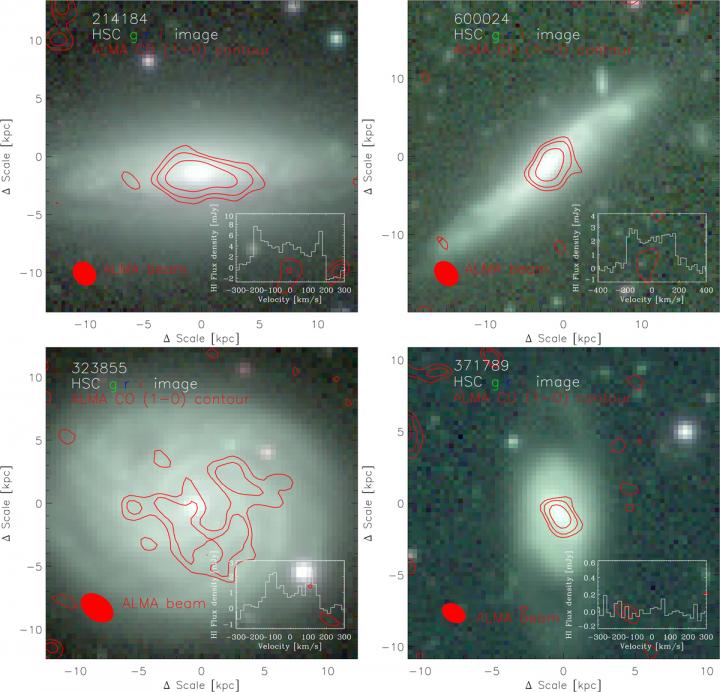FAST detects neutral hydrogen emission from extragalactic galaxies for the first time

The optical color images of the four galaxies for FAST observation. The red contours are the previous CO observation by ALMA. The white spectra in each panel are the results from FAST Credit: CASSACA
Recently, an international research team led by Dr. CHENG Cheng from Chinese Academy of Sciences South America Center for Astronomy (CASSACA) observed four extragalactic galaxies by using the FAST 19-beam receiver, and detected the neutral hydrogen line emission from three targets with only five minutes of exposure each. This is the first publication for FAST to detect extragalactic neutral hydrogen.
The research paper was published in Astronomy & Astrophysics Letter.
Neutral hydrogen gas is the most extended baryons in galaxies, while cold gas traced by CO is more concentrated to a galaxy center (red contour in Fig.1). “With dynamical measurements of neutral hydrogen and CO, we can estimate the mass distribution of galaxies at different radii,” said Dr. CHENG, first author of the study.
Dynamical masses of these four galaxies estimated from the newly observed neutral hydrogen line were 10 times higher than the observed baryon masses, indicating contribution of dark matter.
On the other hand, dynamical masses estimated using previous CO observations were equivalent to their observed baryon masses. Therefore, the new FAST observation illustrated its ability of studying dark matter in galaxies using the neutral hydrogen 21cm emission line.
The FAST observation of these galaxies was an important part of an international research project, the Valparaíso ALMA Line Emission Survey (VALES), led by Prof. Edo Ibar from Valparaiso University in Chile.
The VALES is a project of observing star forming galaxies using first-class international facilities such as Sloan Digital Sky Survey (SDSS), Herschel Space Observatory, Atacama Large Millimeter Array (ALMA), Atacama Pathfinder Experiment telescope (APEX) and Very Large Telescope (VLT).
FAST, with the unpreceded sensitivity, provides a unique chance to observe the extra-galactic neutral hydrogen, and therefore has been added to the list of modern astronomical facilities used by this international collaboration.
Media Contact
More Information:
http://dx.doi.org/10.1051/0004-6361/202038483All latest news from the category: Physics and Astronomy
This area deals with the fundamental laws and building blocks of nature and how they interact, the properties and the behavior of matter, and research into space and time and their structures.
innovations-report provides in-depth reports and articles on subjects such as astrophysics, laser technologies, nuclear, quantum, particle and solid-state physics, nanotechnologies, planetary research and findings (Mars, Venus) and developments related to the Hubble Telescope.
Newest articles

Pinpointing hydrogen isotopes in titanium hydride nanofilms
Although it is the smallest and lightest atom, hydrogen can have a big impact by infiltrating other materials and affecting their properties, such as superconductivity and metal-insulator-transitions. Now, researchers from…

A new way of entangling light and sound
For a wide variety of emerging quantum technologies, such as secure quantum communications and quantum computing, quantum entanglement is a prerequisite. Scientists at the Max-Planck-Institute for the Science of Light…

Telescope for NASA’s Roman Mission complete, delivered to Goddard
NASA’s Nancy Grace Roman Space Telescope is one giant step closer to unlocking the mysteries of the universe. The mission has now received its final major delivery: the Optical Telescope…



